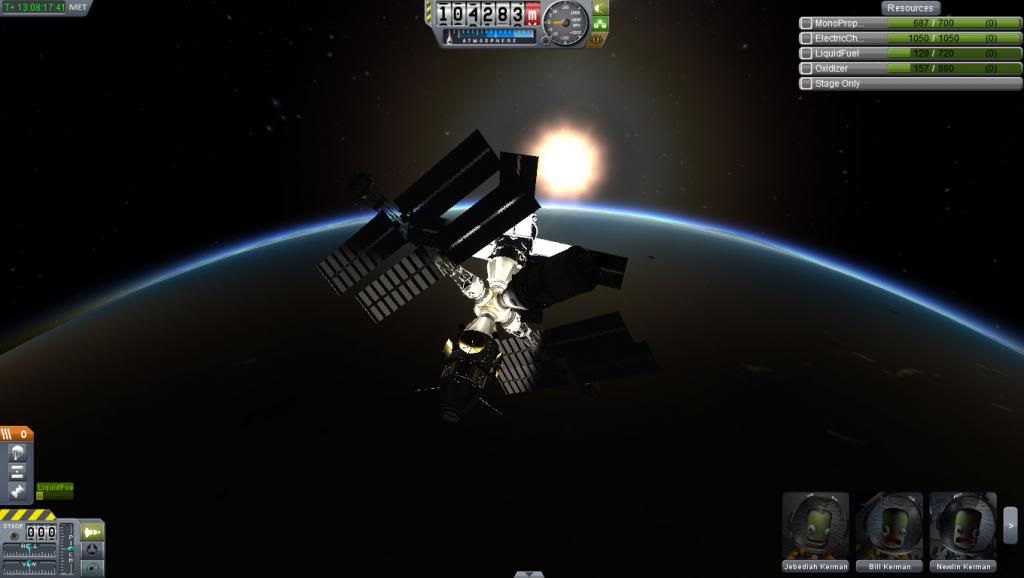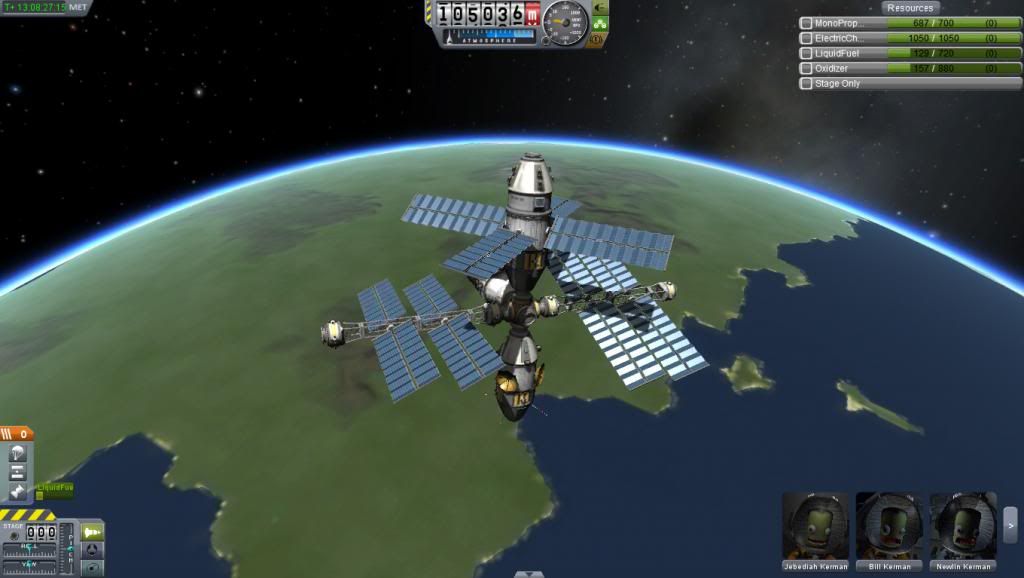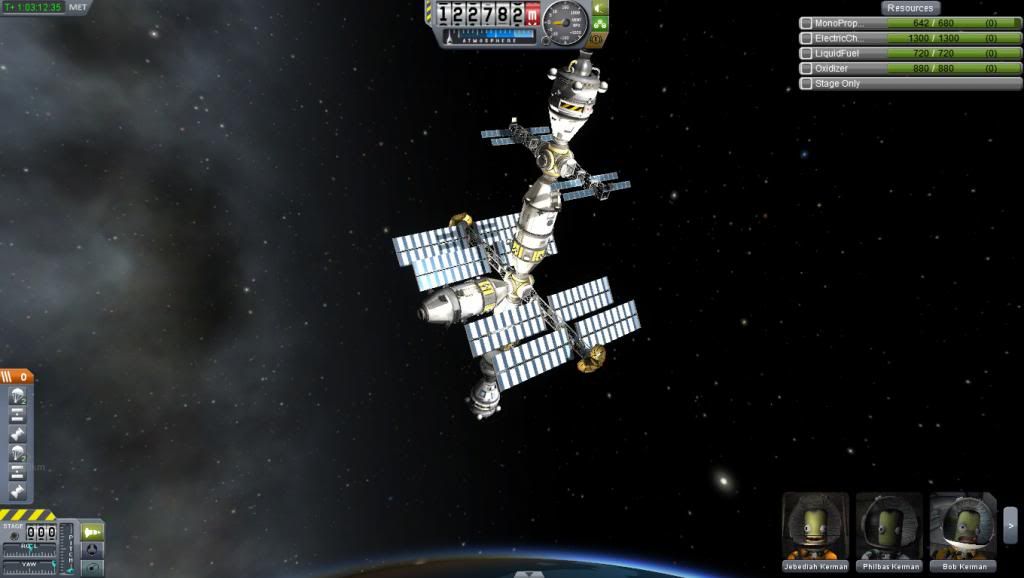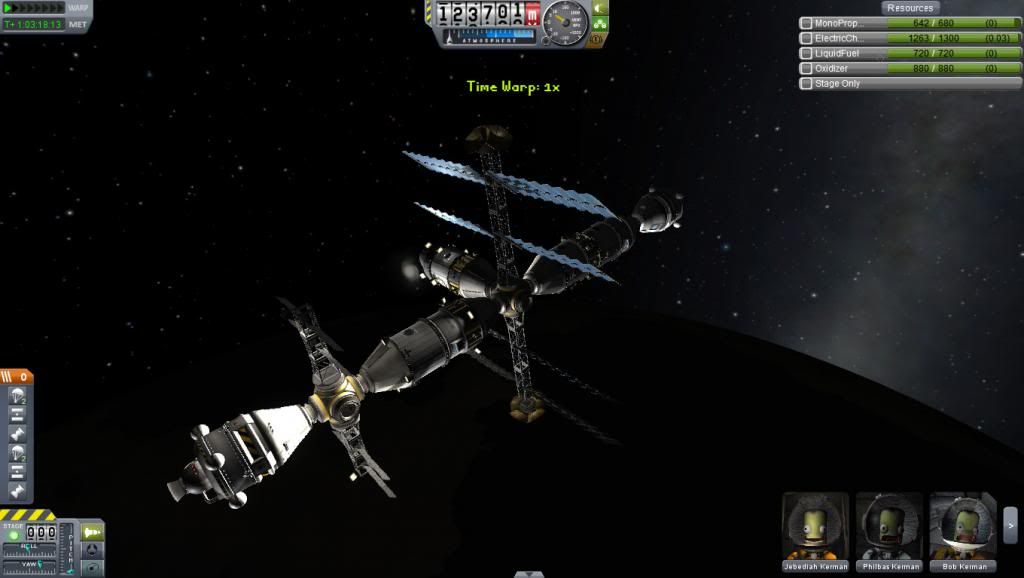I hope you don't mind Warpus if I repost some of your questions from the PM's here. I want to use them to give context to the guide I'm putting together for you.
I'm going to have to re-read this message after I've killed a couple kerbs (kerbals?)
Yes, they are called Kerbals. The planet they live on is called Kerbin. The sun is called
Kerbol. There are 5 planets in the game so far (list from closest to Kerbol out):
Moho (Mercury analog) - very very hot with a highly eccentric and inclined orbit - no moons or atmosphere
Eve (Venus analog) - extremely dense and 'tall' atmosphere. It's atmosphere extends up to 90km (the top of Kerbin's atmosphere is ~70km) and the atmosphere is also 5 times as dense as Kerbins. It's gravity is a little less than 2 times as strong as Kerbin's. Landing at Eve is easy because of the thick atmosphere, but taking off again is very challenging. Eve has a tiny moon called
Gilly that is basically just an asteroid.
Kerbin - Kerbal's homeplanet. The atmosphere extends to roughly 70km, it has the same gravity as earth and the atmosphere is as dense as Earth's. Kerbin has two moons,
Mun (just like the real Moon pretty much) and
Minmus. Minmus is smaller than the Mun with less gravity and it's orbit is eccentric and inclined. Neither of these moons have atmospheres.
Duna - Duna is a Mars analog. It has a thin atmosphere that extends to around 35km. Duna has a moon that is between the size of Mun and Minmus that is called
Ike. Ike has no atmosphere
Jool - Jool is a Jupiter analog. You cannot land on it and it's atmosphere extends to 132km. Jool has five moons -
Laythe,
Vall,
Tylo,
Bop and
Pol. Laythe has a thick atmosphere and Kerbin-like gravity. It is a beautiful waterworld with many scattered archaepalegos. Vall is an ice world that is unremarkable. Tylo is a large planet with nearly the same gravity as Kerbin but has no atmosphere, so it is very difficult to land on. Bop is a captured asteroid much like Gilly. Pol is a new moon that is very rocky and is twice the size of Bop.
______________
Which tutorials do you mean
I meant the two training scenarios you mentioned. Sorry for the confusion. IIRC, the first one will walk you through building a rocket and will teach you how to put it in orbit. The second one allows you to do a Mun landing. Both are extremely helpful and will teach you much of the basics.
(I'm really sorry about the confusion, I didn't mean to frustrate you)
Either way.. my 1 issue is that my S.A.S. module (the "autopilot" one) does not turn on when I press T or F..
There are a few things that could be going on here, so I will explain everything I think could be going on.
First off, all capsules have SAS built in. SAS uses gyroscopes or reaction wheels to put a torque on your spacecraft. This will stabilize the craft and keep it pointin in one direction when you hit T and you see the little SAS icon light up above the navball. If SAS is not lit up, this means you can freely manuever the craft and change it's orientation. When you are manuevering, instead of exerting torque to stabilize the craft, the SAS is exerting torque to move the craft. You do not need to place an SAS module as the capsule has it built in. You only need extra SAS modules if you have a very large craft.
ASAS is advanced SAS. It is not built into the capsules, so you will need to install a module with this. ASAS does not exert any kind of torque, instead, it controls the control surfaces like movable fins, the RCS system and the thrust vectoring of thrust vectorable rocket engines. If you turn on SAS by hitting T or F (F only turns on SAS as long as you press the button, T turns it on or off with one press), then the ASAS will use your fins, vectored nozzles or RCS thrusters to stabilize the craft. It will automatically control the fins and vectored nozzles (the nozzles will only do anything when you are burning your engine) but for it to control the RCS system, you have to turn on RCS by pressing R. A little indicator above the navball will show when they are activated. Make sure that you attach the ASAS module on the first segment below your capsule. If you put it on a lower segment that you jetison when it runs out of fuel, then you will lose ASAS functionality.
*There is not a separate indicator for ASAS. If you press T and the SAS indicator lights up, then ASAS is also on.
**RCS thrusters require RCS fuel tanks. They come in different sizes and they do not have to be attached to the RCS thrusters. If you have an RCS tank somewhere on your rocket, then you can attach RCS thrusters anywhere and they will work even if not connected to the RCS tank if it has fuel left in it.
***Turn off RCS during time warps if you leave SAS on during warps. If you don't, the SAS system will drain all of your RCS fuel during the time warp making unecessary corrections.
Both SAS and ASAS require electricity to run. During launch, the engines will provide the needed power to run it. However, when the engines are off, you lose power. To provide power, you have two options:
1) Solar pannels and batteries (make sure to deploy the panels
after you are out of the atmosphere by right clicking them; you also have to install panels and batteries seperately, they are not a single unit)
2)Radioisotope Thermal Generator (RTG) - If you install this, you don't need other batteries or solar panels, as long as your power requirements are not greater than what it provides, though you can install multiple units.
If you have forgotten pannels, batteries or an RTG, then your A/SAS will not work and your mission will fail.
Also, if you press T and the SAS indicator above the navball doesn't light up and you have panels/RTG or are during the launch phase when the engines power the systems, then you might have a bugged game.
If you press T and the SAS indicator does light up and you still veer off wildly, then your rocket is unstable. Place fins on it, RCS thrusters and make sure it's balanced out (as in make sure the design is symmetrical and not wobbly [correct wobbliness with struts]). A thrust vectored engine will also help you out.
I swear that's what I should be pressing to turn that on (it's T, right?), so I'm thinking that I must not be assembling my rocket right. I tried parachte / capsule / sas / separator module (or whatever it's called).. as well as the last 2 flipped, with the sas being right in front of the fuel. Neither way allows me to turn on my SAS.
It is T. One further problem, you probably installed an SAS module under the capsule instead of an
ASAS module. An SAS will not provide enough torque to stabilize most launching rockets. Swap out the SAS module with an ASAS module and it should work. Your design seems sound otherwise.
__________
Now that you have had time to play, does the PM I sent you about apopasis/peroapsis and prograde/retrograde make sense? If not, let me know and I'll throw up another tutorial with pictures.
Godspeed Warpus, may your Kerbals not die very frequently,
hobbsyoyo









 What should I add next?
What should I add next?

